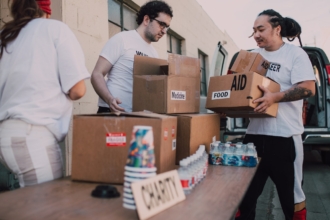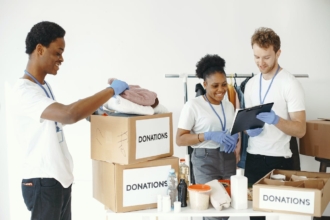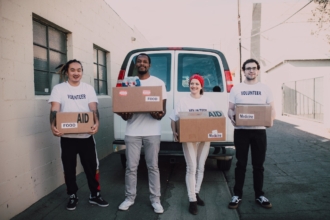Top PTA fundraising ideas
- Craft fair
- Sports day or field day
- School auction
- Shoe drive
- Raffles
- Parents’ night out
- Sell products
- Coupon books
- Cook-off
- Walk-a-thon
- Direct mail appeal
- Board game competition
- Talent show
- Holiday treat sale
- Battle of the bands
- Drive-in movie night
- Restaurant percentage night
- T-shirt sales
- Night at the museum
- Sensitive-document disposal day
- Community cookbook
- Trivia night
- Bowl-a-thon
- Wine tasting
- Haunted house/haunted scavenger hunt
New to your local parent-teacher association (PTA) — or to PTA fundraising? Fundraising events can be a lot of fun for communities, and they can go a long way toward supporting parents, children, and schools.
In this article, we’ll explain a little more about PTA fundraising and offer up 25 PTA fundraising ideas that have proven to be effective at generating additional funds.
The importance of PTA fundraising
Fundraising is a key activity of parent-teacher associations, which are organizations made up of parents, teachers, school administrators, and community leaders for the purpose of supporting children and advocating for their education.
Fundraising involves asking for financial support from community members, usually through carefully planned campaigns and activities. Many PTAs use some of the same fundraising ideas again and again because they have proven to be successful, but there’s always room for creativity! Implementing new fundraising ideas occasionally allows you to involve new people, reach new audiences, and generate more excitement.
PTA fundraising committees usually plan a calendar of activities that align with specific goals the organization is trying to reach throughout the course of the year ahead. Strategizing and budgeting are a crucial part of what makes fundraising efforts successful.
The purpose of PTA fundraising
PTA members need financing to help carry out their mission. Tax dollars can’t cover everything a school wants and needs to do, which is where fundraisers come in — they can help fill in the gaps and are often a source of significant financial support.
The proceeds from PTA fundraisers are used in a variety of ways. For example, they may go toward creating after-school programs, hiring instructional assistants, or hosting events that promote family involvement at school, among other things.
It’s important to note that while PTAs consider fundraising to be important, they also say that it shouldn’t overshadow the main focus of the organization, which is to engage local families and communities in improving children’s education.
25 effective PTA fundraising ideas
1. Craft fair
A craft fair gives the whole community a chance to get involved. You can charge a fee for each vendor table, and you can even sell crafts that students have helped create for extra funds. Be sure to have a prominently displayed donation table highlighting the value of the PTA and the reasons you need donations.
Cost: $
Craft fairs are generally inexpensive, as most PTAs use school or community spaces and ask exhibitors to provide their own tables and chairs. The main costs are associated with providing food for the artisans (if it’s an all-day affair) and advertising for the event to increase foot traffic.
Difficulty: Moderate
How to do it
- Find a venue. A wide-open indoor space is best if the weather in your area can be unpredictable; otherwise, an outdoor space might work nicely and attract more attention.
- Book crafters. Advertise your need for crafters and create a form for prospective crafters to reserve space. Aim to include a variety of craft types and high-quality items to maximize revenue.
- Advertise your event. Create social media posts, flyers, and a web page to get the word out. You may even want to do radio or print ads to reach a wider audience.
Earning potential: $$
In addition to charging a nominal entry fee for attendees, charge a fee for each vendor table, or, alternatively, negotiate a percentage split where both you and the crafters profit from every sale. Raffles (using donated items from vendors) and baked goods are popular money-makers that typically accompany craft fairs.
2. Sports day or field day
A sports day gives students a chance to get active, enjoy friendly competition, and even win some prizes. Designing a day of games that revolve around teamwork will give you an excellent opportunity to promote family and community engagement.
Cost: $
Difficulty: Easy
How to do it
- Choose a location. A large outdoor space like a park or football field is ideal, but have a backup indoor location ready just in case.
- Assemble your team. There will likely be multiple events happening at the same time and a lot of people attending, so you’ll need a fair number of volunteers to keep things running smoothly.
- Create a schedule of events. Include events, locations, and assigned volunteers on your schedule.
- Create scorecards. They’re a great way to keep track of team wins.
- Locate and gather all the equipment needed for games.
Earning potential: $$–$$$
Since these days tend to be long, they’re full of opportunities for all sorts of additional fundraising activities, like a lemonade stand, a bake sale, and a picnic or barbeque. By incorporating just one or two of these fundraising ideas, you could raise significant funds in a single day.
3. School auction
An auction, either in-person or online, can be a great way to quickly generate funds. In contrast to an in-person event, online auctions may run for several days (or even weeks) and allow for more potential donors.
Cost: $–$$$
Costs for silent auctions vary greatly. A basic event would consist of auctioning off entirely donated items and using paper bidding sheets. But if you’re looking to put on a more elegant event, you might want to invest in bidding software, book a nice venue, and offer food and entertainment.
Difficulty: Moderate
How to do it
- Gather the auction items. Reach out to parents and local businesses to ask them to donate auction items to support your goal. Classrooms can also work together to create gift baskets to be auctioned off. Remember that items can also be experiences or perks (like a prime parking spot for a year)!
- Find a venue. A banquet hall or community center is a good option.
- Plan for food. Hors d’oeuvres are perfect for people to walk around with while perusing the auction offerings.
- Arrange for entertainment. It’s a great way to keep things lively.
- Create auction bid sheets to collect names and bidding amounts. This is also a good time to determine starting bid amounts. Alternatively, you could use bidding software for mobile bidding.
Earning Potential: $$$
Auctions tend to have a high ROI in large part because the items for sale are donated, which maximizes profits. You can also strive to include some big-ticket items and bundle items together to get higher bids.
4. Shoe drive
Consider hosting a shoe drive through your school. Shoe drives work particularly well with younger kids, who quickly outgrow their shoes. You can also have classrooms compete against each other to see which donates the most shoes, then offer the winning classroom a prize, like a pizza party.
Cost: $
The only potential cost associated with a shoe fundraiser is the cost of advertising, should you choose to pay for it. In most cases, the organization you partner with will provide everything else.
Difficulty: Easy
How to do it
- Find a fundraising company that will pay you for the shoes you collect. Organizations tend to pay out either by the number of pairs or by the total weight of your collection.
- Set up collection bins. Having multiple bins makes drop-offs more convenient.
- Advertise your fundraiser. Encourage families and students to bring in their unneeded shoes to one of your drop-off points for donation.
- Pack up the collected shoes and send them to the organization.
Earning potential: $
While shoe drives don’t tend to be overly lucrative, you could make a modest amount of money while also helping people in need. They’re also a good alternative to directly asking for money (such as selling tickets for a raffle or to an event). You’re simply asking for an item someone is no longer using.
5. Raffles
Raffles make it easy for people to get involved, even if they don’t have the money to spend on a larger donation, like an auction item purchase. Kids can get involved in selling raffle tickets, and, if you’re running a longer-term raffle, you can sell tickets at events like sports games and other school gatherings.
You might purchase a raffle prize, ask a business to donate a prize, or host a 50/50 raffle. With a 50/50 raffle, there’s no need to worry about a prize, since you’ll give the raffle winner half of the money generated by the raffle. It’s a low-risk way to host a raffle, and it ensures you’ll make a profit.
Cost: $
There are few costs associated with conducting a raffle. As long as someone donates the prizes, you’ll only need to get tickets to sell, if you’re using physical tickets.
Difficulty: Easy
How to do it
- Gather prizes. Ask local merchants for their support to help you reach your goal.
- Recruit volunteers to distribute tickets in exchange for donations. “Selling” tickets is technically against the law. Split up tickets among numerous volunteers to spread out the work.
- Hold the drawing. This could be a standalone event or part of another event.
- Deliver prizes to the recipients. Don’t forget to hand out prizes to your volunteers for a job well done.
Earning potential: $$$
Raffles are generally considered an extremely effective way to raise money. When done well, they can help you raise tens of thousands of dollars from a single raffle.
6. Parents’ night out
Host a fun event specifically for parents, like a night at a local restaurant while a group of volunteers entertains their children. You’ll be able to connect with parents, who tend to be your biggest donors. In addition to charging admission, you can make direct appeals to the parents or incorporate raffles to generate extra funds.
Cost: $
There may be costs associated with the venue or activity you’ve chosen. You’ll also incur some costs for providing snacks, water, art supplies, etc. for the kids and volunteer babysitters.
Difficulty: Easy
How to do it
- Choose/plan the evening’s activity. You can plan bowling nights, pub crawls, sunset cruises — the list is endless! Take an informal survey to find out what would appeal most to your target audience.
- Gather volunteer babysitters and find a venue. Older students are often willing to pitch in and help.
- Promote the event. You can get the word out via social media, local media, and flyers or posters.
Earning potential: $$
Some organizations have earned as much as $12,000 with this type of fundraiser. You can do the same with some creative ideas and thorough planning.
7. Sell products
Product fundraisers have been the go-to option for PTAs, sports teams, clubs, and more for decades. That’s because they work — but you need to choose the right product.
With a product fundraiser, kids will sell products and take pre-orders. Then, you’ll collect those orders and submit them to the product fundraising partner. The key to a successful fundraiser is to choose an in-demand product that people love, like cookie dough, chocolate bars, or wrapping paper.
Cost: $$
Processing and shipping costs can eat into your profits, so be sure to take this — and the percentage split — into account when choosing a merchandise partner.
Difficulty: Moderate
How to do it
- Choose a product that will appeal to your target audience. Take an informal poll or ask a focus group to see what garners the most interest.
- Choose a partner. Find a company that does fundraising for the product you’re interested in selling.
- Create order forms. You may want to create both physical and online forms to collect orders and payments.
- Market your fundraiser. Create flyers, a web page, and social media posts to spread the word
- Create incentives for top sellers and gather prizes from local businesses.
- Distribute the items when the event ends.
Earning potential: $$
You can increase the earning potential of this type of fundraiser if the items you’re selling are customized.
8. Coupon books
Much like selling products, selling coupon books means your buyers will get something they need, and your PTA will receive a portion of the cost of each sale. Your PTA can purchase coupon books from specialized providers, but one of the best strategies is to look for a provider that works with your local businesses. The coupons will be relevant to your audience, and you’ll be giving your local community businesses a boost, too.
You can also offer prizes and incentives to get students excited about selling the books.
Cost: $$
If you choose to work with a coupon book partner, keep costs low by making sure the partner doesn’t require you to commit to a minimum purchase amount. And if you’re creating the coupon book yourself, look for a printer who’s willing to give you a discount on the cost of printing to maximize your revenue.
Difficulty: Moderate
How to do it
- Choose what kind of coupon book you’ll sell. Decide whether you’ll solicit businesses to include (if you’re creating your own book of coupons) or choose a coupon book partner to work with who will produce a generic book of coupons.
- If you choose to build your own book, start putting it together. Solicit local businesses to participate, create the book design digitally, and send it to a printer.
- Sell, sell, sell. Emphasize how much buyers will be saving as a result of using the coupons.
Earning potential: $$
Your PTA will typically receive about 50 percent of the cost of each coupon book, with most books costing between $25 and $35 each. And if you create the books yourself, you can charge advertising sales revenue as well.
9. Cook-off
Get staff, parents, and even kids involved in a fun cook-off event. Pick a dish or two and ask participants to create their best version of the dish. You can charge a fee for each entry and an admission fee for attendees, who’ll get to sample all of the dishes. Judges will vote on the dish they think is the best.
See if you can get a community business to donate a prize or two to make the competition extra fun.
Cost: $–$$
You can keep costs low for an event like this if you’re able to find a free venue. However, you may need to pay for a space, and if you want to attract a large crowd, you may also want to pay for advertising. You’ll also need to provide plates or bowls and utensils for tasting.
Difficulty: Moderate
How to do it
- Find a location. Look for one that can accommodate the expected number of attendees. Remember that even a free space might require you to rent tables and chairs, so take that into consideration when searching.
- Select impartial judges. It’s great if you can find people who have some background or experience in cooking, baking, or food service.
- Recruit contestants. Advertise for participants and create an entry form that clearly outlines the competition rules.
- Gather the awards. Ask local businesses to donate awards (cash, gift cards, free local experiences, etc.) for the top three winners.
- Assemble your team. Secure volunteers and an emcee to run the event.
Earning potential: $$
If you’re able to do a successful cook-off the first time, you’re likely to attract more attendees — and make more money — in future years as it becomes a more established event. Maximize the day’s profits by selling additional foods (offering a dessert station or drinks) and asking for donations outright.
10. Walk-a-thon
A walk-a-thon is a versatile fundraising event that you can use at nearly any school. Students ask people to pledge money for every mile or hour they walk, then they “earn” that money by participating in the event. During the event, you can set up tables to sell beverages, T-shirts, and other items to increase the funds you raise.
There are also plenty of variations on the walk-a-thon you might consider. Options include dance-a-thons, jump-rope-a-thons, and more. The possibilities are endless, and you can easily put a new twist on this traditional fundraising event.
Cost: $
Costs tend to be low for walk-a-thons. According to Fundly, many organizations find that less than 10 percent of the money they raise is needed to cover expenses; the rest goes to the cause.
Difficulty: Easy
How to do it
- Select a time, date, and location for the event. Take into consideration any necessary permits or police support you might need in addition to parking. Don’t forget to choose a rain date.
- Determine how participants will collect money from their supporters. Will you provide them with an online form and payment link for people to fill out? Will you purchase software that allows walkers to create individual websites and collect donations? You could also set up a crowdfunding page that supporters can visit.
- Boost your campaign. Give participants tips and support on how to spread the word and get more donations.
- Assemble your team. Ask for volunteers to run the event.
- Ask for business donations. Recruit local businesses to provide items that will enhance the event, such as breakfast and water for walkers, photo stations, and musical entertainment.
Earning potential: $$$
You can increase the event’s earning potential by selling custom-made T-shirts showing support for the walk-a-thon and offering treats for sale during and after the event. With enthusiastic participants and the right level of support for them, the sky’s the limit on this event’s earning potential.
11. Direct mail appeal
Don’t forget the power of direct mail appeals. Write a fundraising letter to your past donors and to the parents of current students. Be sure to include information about why donations matter so much and what work they’ll help fund. Direct appeals can work particularly well when you’ve a set fundraising goal for a project; donors are able to see the difference their contributions make through the work you perform.
You can include an envelope with your appeals to make it easier for recipients to donate, or include information about how they can donate online.
Cost: $
If you choose to send letters via regular mail, you’ll need to purchase paper, return envelopes, and stamps.
Difficulty: Easy
How to do it
- Develop your letter. Recruit a skilled writer to volunteer to craft the letter. It should indicate a specific goal that the money will go toward and include information on ways parents can donate.
- Distribute the letter. You can do this via mail or email, or you can have students bring them home to their parents.
- Determine how you’ll collect donations. You can set up online donation forms or a physical dropbox for checks.
- Express your gratitude. Send thank-you notes to donors.
Earning potential: $
The success of this fundraiser depends in large part on your letter-writing strategy. The more compelling the appeal (and the more eloquent the ask), the more money you’ll raise.
12. Board game competition
Host a board game night for students, giving them fun, low-cost entertainment. Charge a small registration fee, then structure the night as a tournament so students progress through the ranks with each game they win. (See additional setups below.) A traditional game, like checkers, can work well for this purpose. Alternatives to board games are video games or physical games like corn hole or Jenga. You can offer up prizes to the winners in different age groups.
Cost: $
There are few costs associated with this type of event if families are willing to donate games to play and local businesses are willing to sponsor prizes.
Difficulty: Easy
How to do it
- Choose your event location. A library, community center, or school cafeteria are all good choices.
- Collect the games for the competition. Make sure they’re appropriate for the variety of age ranges that will be involved.
- Decide whether players will play individually or as part of a team. There are also different styles of play, such as open play (where participants play only what they want), round robin tournaments (where each participant plays every other participant at some point), or an elimination-style tournament (where only the winners of each game progress to the next round).
Earning potential: $
With ticket prices at around $5 or $10 per player, this event isn’t likely to make a ton of money, but it could be an excellent way to supplement additional fundraisers. As with many of the other events, you can increase your take by selling food and drinks during gameplay.
13. Talent show
A talent show can be a fantastic and fun way to raise money. Some PTAs take a structured approach and have adults work directly with groups of children to develop an act, such as a choreographed dance. Others leave it up to the individual performers to create and practice their act on their own time. Either way, a talent show is a rewarding activity for students of all ages and their families.
Cost: $
While the monetary costs are minimal for talent shows, it’s fairly time-consuming in terms of organizing the details and managing the participants.
Difficulty: Moderate
How to do it
- Recruit an emcee.
- Recruit performers. You can do this via talent show fliers and school announcements.
- Select the performers. Hold auditions to evaluate the appropriateness of planned performances and to avoid an overabundance of similar acts.
- Organize equipment. Some performers may need specific equipment.
- Assemble your team. Enlist student volunteers to help with various aspects of the show, such as sound and video recordings.
Earning potential: $–$$
The earning potential here is somewhat limited, as the main sources of revenue would simply be collecting donations and selling concessions and/or raffle tickets.
14. Holiday treat sale
The holidays are busy, often chaotic times, and parents will appreciate any efforts that make their holiday preparations easier. If your PTA members are talented bakers, then consider offering holiday treats for sale, like pies and cookies. You can offer these items frozen so they’re ready to thaw and serve at a holiday celebration. Take advance orders so you know just how much cooking you’ll have to do.
Cost: $
Have individual bakers pay for their own ingredients and packaging materials to help keep up-front costs low. It’s possible you may need to pay to set up a table at a particular venue. You could also spend money on advertising to draw a larger crowd (as long as you have enough volunteers to meet the higher demand).
Difficulty: Easy
How to do it
- Choose a day and location to set up your bake sale table. Maximize traffic by holding it on a weekend morning or afternoon, and look into whether or not your desired location requires a permit.
- Assemble your team. Recruit volunteers to do the baking and staff the table.
- Manage your merchandise. Create sign-up sheets (online forms work well) for volunteers to indicate what they’re baking.
- Get the word out. Advertise the sale on social media and printed flyers. State what you’ll be using the funds for to encourage more sales!
Earning potential: $$
Bake sales can be excellent moneymakers. If you pair it with another event — such as a talent show or school auction — you can increase the foot traffic and, hopefully, the purchases.
15. Battle of the bands
Ideal for PTAs in high schools, a battle of the bands gives student musicians a chance to demonstrate their skills. You can also open this event up to local communities. Charge the bands a small registration fee, and charge a small admission at the door. Bands compete, judges rank them, and the winning band takes home the title of the event winner, as well as any prize you’ve been able to secure.
Cost: $$
Unless you can secure a donated space, you may need to shell out money for a venue, advertising, and decor.
Difficulty: Moderate to hard
How to do it
- Choose a venue. You’ll want one that can support sound equipment, a performance area, and a large crowd.
- Recruit bands and judges. Encourage early signups to spread the word and invite other bands they know. Judges could be local music teachers or popular area performers.
- Gather your prizes. Solicit donations from local businesses to use as prizes.
- Get the word out. Advertise the event via social media posts and flyers.
- Develop a schedule for band performances.
- Sell tickets. Remember to give some tickets to the band members to sell to their own support networks.
Earning potential: $$–$$$
If you schedule the event so it includes an intermission, you can sell concessions and other fundraising items during the break. Custom T-shirts would likely appeal to these event-goers and could significantly increase your intake.
16. Drive-in movie night
If your school has access to a large parking lot or field, consider hosting a drive-in movie night. You’ll need a projector and a large screen, or you may be able to project the movie onto the side of a building. Charge admission per car, and consider selling items like drinks and candy for additional fundraising opportunities.
Cost: $$
The cost of a movie license could be the most significant expense associated with this fundraiser. Licenses tend to range from $300 to $2,000.
Difficulty: Easy to moderate
How to do it
- Find a venue. Think in terms of a parking lot or open field. If the parking lot faces the blank outside wall of a building, even better!
- Choose a movie. Consider presenting your target audience with a few options and taking a poll on their preference, or perhaps there’s a movie that has a clear connection to your cause. Remember, you’ll need to get a license to show the film.
- Plan for a concession stand. Ask local businesses to supply free (or discounted) goodies and refreshments for sale.
- Assemble your team. Recruit volunteers to work the projector, sell tickets, and run the concession stand.
- Get the word out. Advertise the event.
Earning potential: $–$$
Make a direct pitch to your audience for additional funds by speaking briefly about your goal, and have multiple ways available for people to donate. QR codes are a great option to allow people to donate quickly and easily.
17. Restaurant percentage night
Look for family-friendly restaurants in your area that host special nights where they donate percentages of all sales to a local nonprofit. These fundraisers require minimal prep work, so you can easily add them into your existing fundraising efforts. Your biggest job will be spreading the word about the night and encouraging students and their families to eat at the restaurant during the event.
Cost: $
There are no costs associated with running a restaurant night fundraiser.
Difficulty: Easy
How to do it
- Choose a restaurant and a date. Wednesdays and Thursdays seem to be the best days for hosting this type of event.
- Develop advertising. Promote the event via social media and flyers.
- Get the word out. Distribute flyers that guests can bring to the venue in order to participate. (Leave some at the restaurant in case guests forget to bring them.)
Earning potential: $$–$$$
Donations tend to range from 5–30 percent of food sales. Depending on the specific restaurant’s policy and the number of guests who show up, you could earn a substantial amount with little effort.
18. T-shirt sales
T-shirts tend to be easy to sell, especially when you’ve customized them with your school’s logo. Alternatively, consider holding an art contest and asking students to enter their shirt designs. The winning design will appear on the shirts. You can sell them by using order forms, but you can also sell them at other fundraising events as well.
Cost: $$
Print-on-demand companies make these fundraisers easy, though you’ll save money by purchasing printed shirts in bulk. Check around and see if a local business offers T-shirt printing, and you may be able to save even more.
Difficulty: Easy
How to do it
- Plan your T-shirt design. Will you use your school’s logo or hold a design contest? Or maybe your school has a unique catchphrase you could incorporate into a compelling design.
- Choose the T-shirt company you’ll work with. In addition to considering the overall cost of the shirts, consider other factors like product quality, delivery assistance, and more.
- Determine pricing. Many printing companies can help you set a strategy that keeps prices reasonable but also allows you to make a profit.
- Get the word out. Lean into the “limited time” angle to encourage people to act — and clearly state your sales goal to generate excitement.
Earning potential: $$
Taking into consideration that your PTA might receive approximately 50 percent of the cost of each T-shirt, this fundraiser has the potential to net a good amount for your organization.
19. Night at the museum
Going to a museum after hours feels special. You can give parents and community members that feeling by partnering with a local museum and hosting a nighttime event created especially for them. Provide appetizers and make a few docents available, and you’ll have the makings of a unique, enjoyable event. This idea works particularly well when there’s a special exhibit in town for a limited time.
Cost: $$–$$$
Live music, food and alcohol, and guided tours at the museum add up to some hefty up-front costs for an event like this. For many organizations, this would be the biggest event of the fundraising year. But if you’re able to make the night elegant and memorable, the earning potential is well worth the effort.
Difficulty: Hard
How to do it
- Select your location. Find a museum that’s willing to partner with you.
- Determine the event’s level of formality. Will it be a casual affair or black tie? Will it be based on a theme? Your answer will dictate the level of planning needed and the elements to be organized.
- Assemble your team. Recruit volunteers to help with the overall planning.
- Publicize the event and sell tickets.
- Show your gratitude. Thank all volunteers, sponsors, and attendees after the event is over.
Earning potential: $$$
A “night at the museum” fundraiser can be a significant revenue generator for your PTA. You can also pair this type of event with a silent auction.
20. Sensitive-document disposal day
This event accomplishes two things: It raises awareness of information security and identity theft, and it gives people a way to dispose of old paperwork. Plus, it’s fairly easy to pull off.
Simply choose an easily accessible parking lot or other open space, connect with a shredding company that’s willing to come on-site, and promote the event to your local community. This is a great option if you plan to use the funds for a “green” initiative, such as starting a composting program at school, replacing styrofoam containers, etc.
Cost: $
If the shredding company is willing to donate its services, costs are minimal.
Difficulty: Easy
How to do it
- Choose a shredding company to partner with. The company should provide everything necessary for shredding, possibly even a few people to work the event and some marketing.
- Choose a date, time frame, and venue. Saturdays tend to be best, from mid-morning to mid-afternoon.
- Recruit volunteers to work the event. They’ll need to help transfer documents from cars, direct traffic, and move out shredded bins.
- Get the word out. Promote the event via social media, flyers, and other avenues.
Earning potential: $–$$
With the right promotion, this kind of event has the potential to attract hundreds of local residents. By charging a fee for every box or bag of documents or a small flat fee, it can generate a decent ROI.
21. Community cookbook
Creating a cookbook might sound daunting, but it’s not as hard as you might think. There are a number of companies that manage everything from recipe collection to book layout to production and can provide both attractive hard copies as well as digital flipbooks. Plus, community members will likely jump at the chance to submit the family recipes they’re most proud of — and be more than happy to purchase a copy for themselves.
Cost: $$
Working with a printing company is the most significant cost for a cookbook fundraiser. Look for a company that has a lot of experience with fundraising groups and offers good customer service as well as a high-quality product.
Difficulty: Moderate
How to do it
- Plan the specifics of your book. Decide on a theme for your cookbook, or specific categories of foods. What types of recipes do you want to include?
- Collect recipes. Spread the word to generate interest in and excitement around recipe submissions. Create a recipe collection form to gather them.
- Test the recipes. Be sure to ask for any clarifications or adjustments as needed.
- Recruit a photographer. You’ll make the cookbook more appealing by adding pictures of finished dishes or baked goods.
- Produce your cookbook. Work with a printing company to print the cookbooks.
- Market and sell the books. Promote it on relevant websites and social media accounts, ask contributors and others to sell copies, and create flyers to post at local businesses.
Earning potential: $$$
Cookbooks tend to be popular — and your contributors are (nearly) guaranteed buyers! Organizations can make as much or as little as they want, depending on the amount of effort they invest in the product. Cookbooks often sell for two to four times their cost, and your profits could range anywhere from the low thousands to as much as $50,000.
22. Trivia night
Trivia nights require little monetary investment but more volunteer time and effort. First choose a venue, which could be anywhere from an outdoor park to a local restaurant to a community center. Then you’ll need to pull a team together to brainstorm a list of questions (themes are a good way to draw people in) and choose an emcee to be the host. You’ll raise funds via entry fees, either per player or per team.
Cost: $–$$
The costs will mainly depend on your venue. You could choose to rent a space and run a bar yourself, which would cost more up front but would also be more lucrative in the end. Or, you could ask a local restaurant or pub to donate space for the night (in which case, they’ll get the food/beverage money). To help lower costs, try to find sponsors who are willing to contribute in exchange for free advertising at your event.
Difficulty: Moderate to hard
How to do it
- Choose a date, time, and venue for the event. Wherever you choose to hold your event, make sure it can accommodate the expected number of attendees and has a good audio system.
- Plan out your questions. Decide if you’ll create the questions yourself or purchase a prepackaged set of trivia questions and answers.
- Recruit someone to act as the evening’s “quiz master.”
- Gather all the necessary supplies. You’ll need things like a scoreboard, speakers, microphones, and paper/pencils.
- Gather prizes. Ask local businesses to donate prizes and perhaps even sponsor a round of questions.
- Get the word out. Promote the event via social media, websites, emails, and flyers.
Earning potential: $$–$$$
If you plan a trivia night well, you can expect to raise several thousand dollars. (One school raised as much as $85,000!) Increase this event’s earning potential by running a 50/50 raffle or playing games that cost additional money. You can also ask teams to fundraise on their own prior to the event.
23. Bowl-a-thon
If you’re looking for a more physically active competition, consider organizing a bowling tournament. (Similar alternatives would be bocce ball, croquet, or disc golf.) Players form teams of four to eight people and pay a registration fee to participate.
To maximize your intake, look for vendors who are willing to help sponsor the event (providing a location, food, and even team T-shirts for free) and consider running a raffle or selling snacks or desserts throughout the event.
Cost: $
There are few up-front costs associated with a bowl-a-thon if the venue and food provider are willing to donate their services or significantly reduce the price.
Difficulty: Easy
How to do it
- Choose a date and secure the venue.
- Determine the structure of the event. Will it be based on the number of games or a time limit? Will there be any other scoring factors aside from the traditional game play (such as the most strikes or best bowling form)?
- Plan a few “pay to play” games. Adding these to the bowling event will up the entertainment factor and bring in more money.
- Settle on your food supplier. Arrange for the venue, your organization, or a catering service to supply food.
- Gather your prizes. Recruit local businesses to supply prizes.
- Promote your event. Don’t forget to post flyers at the bowling alley and create a signup sheet online.
Earning potential: $$
You can earn more money — and make the experience more fun — with “add-ons” to the main bowling competition, such as a photo booth, skill challenges, a “donate” lane, and more. You can also sell T-shirts so people have a memento of the day.
24. Wine tasting
This event is a perfect pairing for your community if you have a local wine bar or winery owner who’s willing to partner with you. Done well, a wine tasting event can be engaging and memorable — and it can raise a consider amount of funds from ticket sales and wine sales.
You can enhance the event with a volunteer wine expert to lead guests through the tasting. Also, consider mixing things up a bit by incorporating a wine bottle ring toss, a wine pull game, or a wine tasting quiz. Don’t forget to make sure food is available for guests.
Cost: $$
If you can get a supplier to donate wine and a venue for free, you can keep costs fairly minimal for a wine tasting fundraiser. However, keep in mind you’ll also need to provide glassware for the event, as well as bottle openers, tasting notepads for guests, and information about each of the wines you’re offering.
Difficulty: Moderate
How to do it
- Choose a date and a venue. Weekends are best, and if you have a local winery, see if they’d be willing to get involved. If not, rent out another venue and acquire the wine yourself.
- If necessary, arrange for several different winemakers to (hopefully) donate wine. You may need to supplement by purchasing some additional bottles yourself.
- Plan for entertainment. You can go with something easy, like a volunteer DJ, or go big with a live band.
- Arrange for food/snacks to serve.
- Assemble your team. Recruit volunteers to check IDs, answer questions, or act as designated drivers if needed.
- Gather gifts for the event. Solicit items for “goody bags” that you can hand out to guests as they leave.
- Consider bringing in a “wine educator” to add interest.
- Promote the event.
Earning potential: $$–$$$
A silent auction pairs well with a wine tasting event and can significantly increase your intake.
25. Haunted house/haunted scavenger hunt
In October, many families are looking for family-friendly Halloween activities. With a bit of work your PTA could give them exactly what they want!
Take over the school gym, a community center, or another wide-open space; hang up some scary decorations; and recruit volunteers to don costumes and ham it up. Sell tickets for admission and make snacks and cider available for an additional revenue stream.
A similar alternative is a Halloween scavenger hunt. Create clues around a theme — think witches, ghosts, or zombies — and decorate your open space to incorporate a list of scavenger hunt items for participants to find. Add prizes and some fun extra challenges (for example, do your best werewolf call or zombie walk), and you’ve got the makings of a high-energy fundraiser that’s fun for all ages.
Cost: $
You’ll likely need to purchase some additional Halloween decorations to pull this off, but with a little creativity, those costs can be minimal.
Difficulty: Moderate to hard
How to do it
- Find a venue and reserve a date.
- Decide on a theme for the haunted house. Some good themes include crazy clowns, mad scientists, zombies, or popular scary movies.
- Gather Halloween decorations. The more you can get from community members — either through donations or loans — the better! Don’t forget about spooky music, sound effects, lighting, and costumes.
- Assemble your team. Recruit volunteers (lots of them!) to work the event and create a signup form for shifts.
- Consider your layout. Plan how you’ll move guests through the house in a safe and timely manner.
- Create additional earning opportunities. Incorporate food and games surrounding the haunted house and charge for participation, such as activity stations for small children that include coloring or pumpkin decorating.
- Promote the event.
Earning potential: $$
If you ask student volunteers to promote the event among their own networks, you’re likely to get fairly high attendance and a good fundraising haul.
Tips for PTA fundraising success
Once you’ve chosen the fundraising ideas you’d like your PTA to try, it’s important to keep the whole process organized. Jotform makes that easy. With Jotform, you can create signup forms, order forms, donation forms, surveys, and more to support your fundraising efforts.
And if you want to make your donation process even more convenient, you can build your own mobile app with Jotform Apps. You can use your app to collect volunteer information, share details about your nonprofit, and even add Jotform’s Donation Box feature to collect donations in the app.
When you use the Donation Apps, you can choose from one of Jotform’s 30-plus payment processor integrations to effortlessly take payments. Just pick the one that works best for your parent-teacher association, and you’ll be set to share your app and accept donations.
Jotform offers a wide assortment of nonprofit forms and templates, plus nonprofits enjoy 50 percent off all annual Jotform plans. Jotform can simplify everything — from sending out fundraising invitations to tracking an event guest list.
Photo by Sherise Van Dyk on Unsplash























Send Comment: